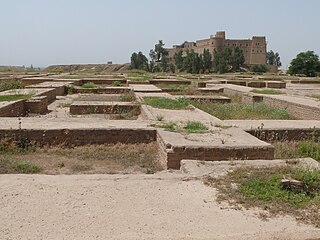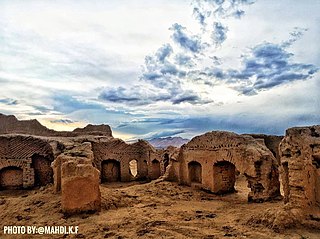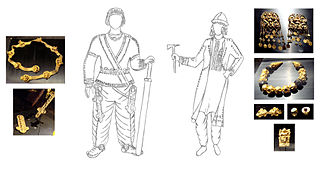
Susa was an ancient city in the lower Zagros Mountains about 250 km (160 mi) east of the Tigris, between the Karkheh and Dez Rivers in Iran. One of the most important cities of the Ancient Near East, Susa served as the capital of Elam and the Achaemenid Empire, and remained a strategic centre during the Parthian and Sasanian periods.

The Bactria–Margiana Archaeological Complex or Oxus Civilization, recently dated to c. 2250–1700 BC, is the modern archaeological designation for a Bronze Age civilization of Central Asia, previously dated to c. 2400–1900 BC, by Sandro Salvatori, in its urban phase or Integration Era.

Jiroft is a city and capital of Jiroft County, Kerman Province, Iran. At the 2006 census, its population was 95,031, in 19,926 families. It is located 230 kilometres (140 mi) south of the city of Kerman, and 1,375 kilometres (854 mi) south of Tehran along Road 91. In the past it was also called Sabzevaran, and on account of its being very fertile land it is famous as Hend-e-Koochak .The civilization found in Jiroft is one of the oldest human civilizations and the manuscripts obtained from this civilization are before the cuneiform discovered in Mesopotamia.

The Proto-Elamite period, also known as Susa III, is a chronological era in the ancient history of the area of Elam, dating from c. 3100 BC to 2700 BC. In archaeological terms this corresponds to the late Banesh period. Proto-Elamite sites are recognized as the oldest civilization in the territory of present-day Iran.

Roman Ghirshman was a Ukrainian-born French archeologist who specialized in ancient Persia. Ghirshman spent nearly thirty years excavating ancient Persian archeological sites throughout Iran and Afghanistan.

Shahr-e Sukhteh, c. 3200–2350 BC, also spelled as Shahr-e Sūkhté and Shahr-i Sōkhta, is an archaeological site of a sizable Bronze Age urban settlement, associated with the Helmand culture. It is located in Sistan and Baluchistan Province, the southeastern part of Iran, on the bank of the Helmand River, near the Zahedan-Zabol road. It was placed on the UNESCO World Heritage List in June 2014.

Tepe Sialk is a large ancient archeological site in a suburb of the city of Kashan, Isfahan Province, in central Iran, close to Fin Garden. The culture that inhabited this area has been linked to the Zayandeh River Culture.

Teppe Zagheh is an early urban settlement located near Qazvin, Iran. In Persian, Tappeh means "tell, mound". It was first excavated by a team from the University of Tehran under the direction of Ezzat Negahban in the early 1970s
Tapeh Yahya is an archaeological site in Kermān Province, Iran, some 220 kilometres (140 mi) south of Kerman city, 90 kilometres (56 mi) south of Baft city and 90 km south-west of Jiroft.
Gonur Depe is an archaeological site, dated from 2400 to 1600 BCE, and located about 60 km north of Mary, Turkmenistan consisting of a large early Bronze Age settlement. It is the "capital" or major settlement of the Bactria–Margiana Archaeological Complex (BMAC).

Mundigak is an archaeological site in Kandahar province in Afghanistan. During the Bronze Age, it was a center of the Helmand culture. It is situated approximately 55 km (34 mi) northwest of Kandahar near Shāh Maqsūd, on the upper drainage of the Kushk-i Nakhud River.

Cheshmeh-Ali is an ancient recreational place, located in the south of Tehran and north of Rey in the country of Iran. The spring is spot in the neighborhood of Ebn-e Babooyeh, Tughrul Tower, and below the Rashkan castle and next to Rey Castle and Fath Ali shah inscription. In the past, carpet sellers and people used to wash their carpets there, with their idea that the property of this spring water is good and clean for carpets and make them full lighter color by its mineral water.

Tepe Hissar is a prehistoric site located in the village Heydarabad just south of Damghan in Semnan Province in northeastern Iran.
Shir Ashian Tepe is a prehistoric archaeological site in the Semnan Province of Iran, situated in Shir Ashian, about 15 kilometres southwest of Damghan.

The Leyla-Tepe culture of the South Caucasus belongs to the Chalcolithic era. It got its name from the site in the Agdam district of modern day Azerbaijan. Its settlements were distributed on the southern slopes of Central Caucasus, from 4350 until 4000 B.C.
The mosaic dance of Iran is as vibrant as the country's cultural diversity, and the Iranian dances are the colorful tapestries of practices which permeate the country, as well as the Iranian diaspora. The Luri dances include a range of folk dances popular among different groups of Lur people which have formed, developed and transferred during the subsequent generations. They usually include common Iranian dances; Collective dances and quadrille, the circular arrangement, and the colorful clothing.
Bronze Age in Azerbaijan began in the second half of the 4th millennium BC and ended in the second half of the 2nd millennium BC, while the Iron Age commenced in approximately 7-6th centuries BC. The Bronze Age in the territory of today's Azerbaijan is divided into the early Bronze Age, the middle Bronze Age and the late Bronze Age. Bronze Age was studied in Nakhchivan, Ganja, Dashkasan, Mingachevir, Gobustan, Qazakh and Karabakh.

The Nakhchivan culture, also known as the Kizilveng culture or Painted Pottery culture, was formed during the Middle Bronze Age in the 3rd and 2nd millennium BC. The main center of painted pottery were Nakhchivan and the Arpachay Valley, in Anatolia, Urmia lake basin and the South Caucasus. In Azerbaijan, this culture was studied on the basis of archeological materials from the I Kultepe, II Kultepe, Shahtakhti, Gizilburun, Nahjir, Shortepe, Garachuk, II Gazanchi qala and other monuments. The painted pottery culture was studied by Azerbaijani archaeologists such as O. Habibullayev, V. Bakhshaliyev, V. Aliyev and A. Akbarov. According to V. Bakhshaliyev, the formation of this culture dishes in Nakhchivan was connected with the formation of the city states.

The Anau culture was an ancient agricultural civilization of Central Asia centred in southern Turkmenistan. It started during the Chalcolithic period around 4000 BC, following the Neolithic Jeitun culture. It is named after its main site of Anau, Turkmenistan.

Yemshi Tepe, also Emchi-Tepe or Imshik, is an ancient circular fortress in Afghanistan, 5 kilometers to the northeast of the city of Sheberghan.It is about 100 kilometers west of Balkh, the capital of ancient Bactria.




















